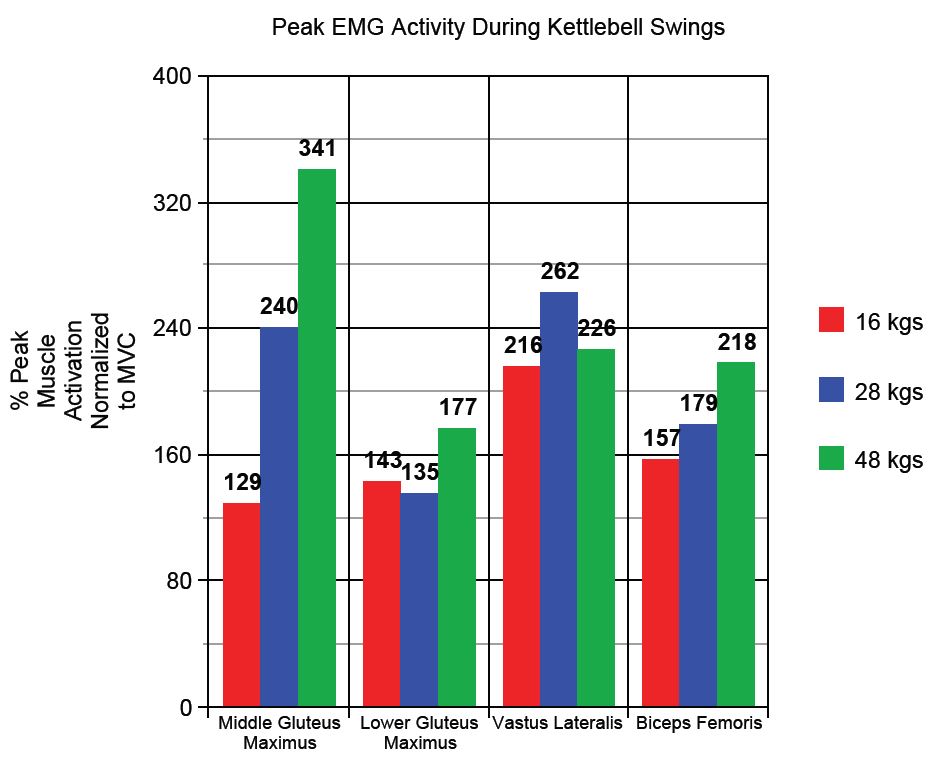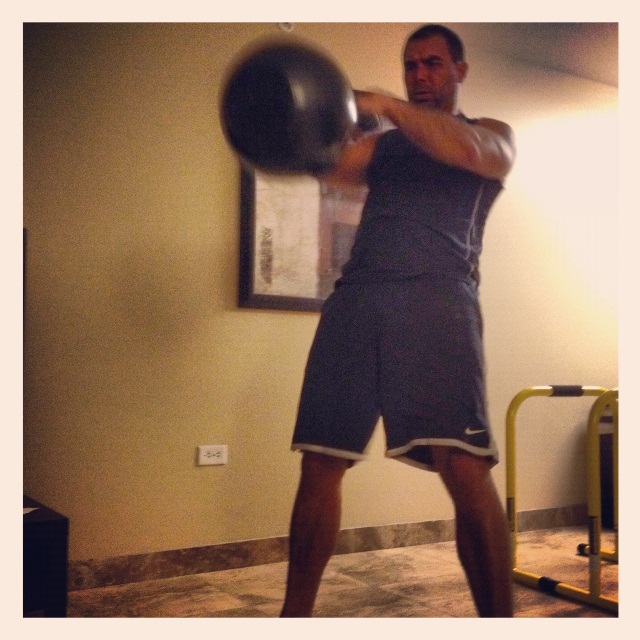Kettlebell swings are an amazingly versatile exercise. A proficient swinger will be able to pick up squats, deadlifts, and hip thrusts very quickly due to both superior hip hinging coordination and end-range hip extension prowess. Swings can be performed with lighter loads for ultra-high reps to build muscular endurance and aerobic conditioning, and they can be performed with heavier loads for medium-to-high reps to build strength, explosive hip power, anaerobic conditioning, and even muscular shape in the posterior chain.
In a prior article, I discussed the merits of heavier kettlebell swings. Click HERE to read it. In the article, I posted the chart below which showcased the ground reaction forces (GRFs) associated with two types of swings (squat style versus hip-hinge style) with two different loads (medium and heavy).
As you can see, squat style swings appear to generate greater peak vertical force, at least with lighter loads, compared to hip-hinge style swings, however hip hinge style swings produce far greater peak horizontal force compared to squat style swings.
You will also notice that the heavier loads generate greater GRFs, and that this force increase is even more pronounced in the horizontal vector.
Keep in mind that this chart is n = 1. Hopefully in time a study will emerge will a sufficient sample size, but my guess is that the results will be duplicated as it’s common biomechanical sense to me.
Why do Hip Hinge Style Swings Produce Greater Horizontal GRF’s?
In a previous article, I discussed why I felt that heavy kettlebell swings should be utilized for athletic strength & conditioning. Click HERE to read that article. I mentioned that heavy kb swings would be a great exercise for improving hip power, acceleration, and speed.
Hip power is determined by multiplying hip extension torque by hip extension angular velocity. My guess is that the swing would produce greater hip power than power cleans, power snatches, or jump squats, due to the fact that the latter lifts only contain vertical components whereas the swing also contains a large horizontal component. This research has not yet been conducted as of yet.
However, the horizontal component (horizontal GRF’s) is largely regulated by hip extensor muscle force. The greater the glute and hamstring strength and power, the greater the horizontal force production potential. Recent high-quality research has shown this to be true in sprinting, that is, the glutes and hamstrings counteract the hip flexion and knee extension torques induced by gravity, motion, and ground reaction (see abstract HERE). Finally, Lake & Lauder showed in an excellent study that kb swings produced a greater impulse (impulse equals force multiplied by time) compared to squats and jump squats, indicating that they may be superior in some regards (see abstract HERE, see larger review of the study HERE).
Increased Hip Extensor Activation with Progressively Heavier Kettlebell Swings
Now that I’ve discussed GRFs, I’d like to shift the attention to muscle activation.
I asked my friend Marianne Kane, a proficient and experienced kettlebell swinger, to perform kettlebell swings with 16 kg, 28 kg, and 48kg while electrodes were place on her glutes, quads, and hamstrings and electromyographic (EMG) activity was recorded. Before the swings, maximum voluntary isometric contractions (MVICs or MVCs) were performed so that the data could be normalized to those positions (which explains how you can get over 100% activation – if the activation induced by the dynamic exercise exceeds that of the isometric exercise). The chart below showcases the results.
It is useful to examine the data in graphical form. Here is the mean muscle activity:
And here is the peak activity:
You will notice a couple things from these charts/graphs:
- The gluteus maximus exhibits the largest peak muscle activation during kettlebell swings.
- The vastus lateralis is the only muscle that doesn’t rise linearly across the three loads; the gluteus maximus and biceps femoris and hamstrings continue to contract harder with heavier loading.
Keep in mind that this chart is n = 1. Hopefully in time a study will emerge will a sufficient sample size, but my guess is that the results will be duplicated as it’s common biomechanical sense to me.
Conclusion
I’m sure that different sweet-spots exist for kettlebell swing loading that maximize various mechanical parameters. Obviously velocity is maximized with the lightest loads and force is maximized with the heaviest loads. However, power is likely maximized somewhere in between (keep in mind that squat jump power is maximized with no loading or just bodyweight, whereas power clean power is maximized at around 85% of 1RM). If I had to guess, I’d say that swing power is probably maximized at around 30% of bodyweight in experienced swingers.
Furthermore, a sweet-spot likely exists for maximizing muscle activation as well. Having experimented with all sorts of kettlebell loads and heavy implements (such as the kettleclamp, Hungarian core blaster, and plateau buster), I can tell you that the heaviest loads possible are not optimal for kettlebell swings. For example, if I do swings with 300 lbs, my range of motion (ROM) is compromised, my power output diminishes drastically, and my hip extensors (glutes and hammies) don’t contract as forcefully. However, I don’t get anything out of swinging 16 kg kettlebells.
If possible (due to equipment availability), I recommend pyramidding loads for swing sets. For example, Marianne might be well-served performing 6-15 explosive swings with 16 kgs, then 28 kgs, then 48 kgs, then 28 kgs then 16 kgs. I might be well-served performing 6-15 explosive swings with 48 kgs, 92 kgs, 92 kgs again, and then 48 kgs.
If you perform kettlebell swings with the intention of shaping the glutes and hamstrings, make sure you progress over time and use heavier loading. Heavier loads during kettlebell swings activate the glutes and hamstrings to greater degrees and therefore place the muscles under greater tension, thereby creating greater hypertrophic stimuli.
Do not jump into heavy swings too quickly. If you’re a beginner, you’ll likely want to first master the kettlebell deadlift and cable pull-through, then the kettlebell deadlift/swing hybrid (click HERE to see this movement), and then finally move onto swings (click HERE to see videos for kb swing form). Make sure your form is stellar with light loads before moving on to heavier loading.
Over the course of several years, however, you should indeed move up in loading. I’ve found that advanced women can hold great kettlebell swing form with 48 kgs, and advanced men can hold great form with 92 kgs. That should give you a long-term goal.












Great article Bret! What is your kettlebell load on the photo above?
92 kgs, or 203 lbs
Would you surmise that the American style swing has less or more gluteal contraction?
So how do you think the heavy KBs compare in glute activation to barbell glute bridges / barbell hip thrusts?
The absolute worst thing you can do is the Crossfit Style swing. The old time American now known as Russian methods, hard styleee, or one true way, AKC, whatever, but never add that ridic pull and heave the @fit dummies do. If your desire is to be a another xfit injury story then disregard.
I’ve been going to XFit for over a year and have never had any other instruction than what is illustrated by Bret. There are good and bad coaches out there in every gym….gotta do your homework and make sure you are training to injury. Not everyone at XFit throws their brain out the window. And most people that I know in my box aren’t dummies
CORRECTION….NOT training to injury
very fine post on swings Bret. I have several kettlebell certs. but am not a kettlebell Nazi so I sometimes do heavy swings with a pipe arrangement so I can put 10-35lbs. Oly plates and do max weight. sometimes I use heavy dumbbells and swing outside the leg. I am also a crossfitter of sorts as I don’t teach in a “box” but I don’t do the full swing overhead, as when you get gassed, you get sloppy and make it a landmine press. at my age swings allow me to max out the glute max/hip flexors so I don’t have to endue heavy squatting, thanks
92kg!! Nice work. I find that going heavy changes the swing dynamic hugely. I have to maintain a much tighter core and focus.
Hey, Brett quick question: are the EMG scores of the swings with Marianne on the same scale as your testing here?
https://www.t-nation.com/training/inside-the-muscles-best-leg-glute-and-calf-exercises